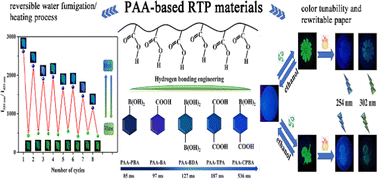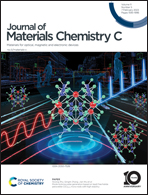Color-tunable and ultralong organic room temperature phosphorescence from poly(acrylic acid)-based materials through hydrogen bond engineering†
Abstract
Color-tunable and ultralong organic room temperature phosphorescence (URTP) materials have drawn extensive attention due to their various applications in many fields. Herein, a series of poly(acrylic acid) (PAA)-based RTP materials are facilely constructed through hydrogen bond engineering by binary doping of PAA with phenylboric acid and benzoic acid derivatives. PAA-based RTP materials all exhibit long lifetimes, and PAA–4-carboxyphenylboronic acid (PAA–CPBA) shows durable afterglow (more than 12 s) with an ultralong phosphorescence lifetime (up to 536 ms) under ambient conditions. PAA–1,4-benzendiboronic acid (PAA–BDA) displays multicolor tunable phosphorescence by changing the excitation wavelengths or BDA doping concentrations. Most impressively, the phosphorescence color of PAA–CPBA can change from blue to green by water vapor fumigation, and return to blue again through heating treatment. After sequential water vapor and heating treatment, the phosphorescence peak of PAA–CPBA is red-shifted from 425 nm to 525 nm with the excitation wavelength increasing from 230 to 300 nm. PAA-based RTP materials are further applied in information encryption and rewritable paper on the basis of the properties of ultralong luminescence lifetime and color-tunability. This work provides inspiration for the design and preparation of color-tunable polymer-based URTP materials.



 Please wait while we load your content...
Please wait while we load your content...